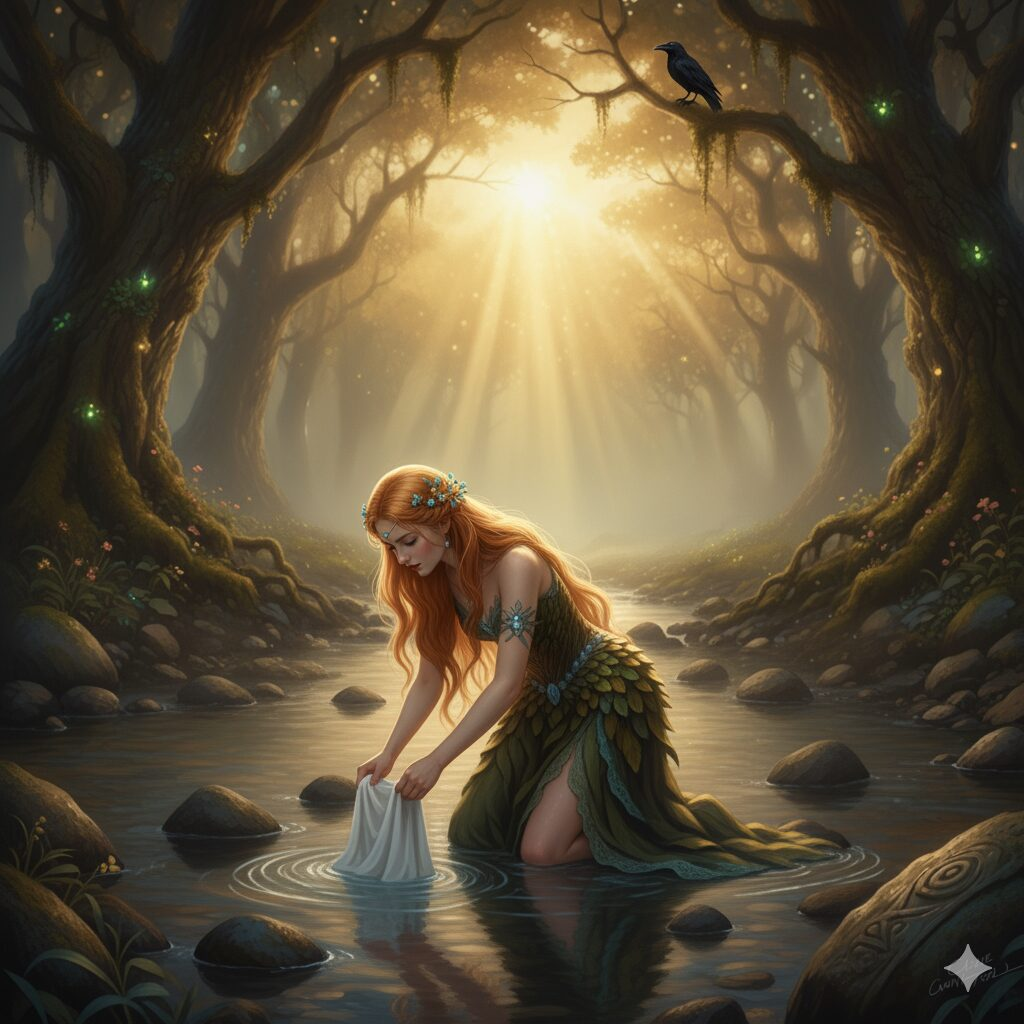How Modron First Came Into My Awareness
I came across Modron many moons ago while reading about Welsh mythology. It was the stories of Morgan La Fay that first brought her to my attention.
Who Modron Is
Modron’s name literally means Mother in Old Welsh, and she appears in the Mabinogion, the medieval Welsh collection of tales that preserve fragments of older Celtic myths.
She is the daughter of Afallach, the Otherworldly king of Avalon (Ynys Afallach), which situates her between the mortal realm and the supernatural. Her most well-known role is as the mother of Mabon ap Modron, a child taken from her in infancy. Beyond that, she is a figure of endurance, motherhood, and connection to cycles of loss and return.
Some scholars link her to the continental Deae Matres/Matronae, mother goddesses of Roman Britain and Gaul; however, in Welsh texts, her story stands alone. There have also been connections with her and Morgan La fay in the Arthurian legend. Both are linked to Afallach/Avalon, associated with otherworldly magic, and connected to maternal or protective roles. While the texts do not explicitly make this claim, the parallels in their stories, mystical women tied to Avalon who influence heroes, suggest that Modron’s archetype may have inspired later figures, such as Morgan le Fay. I personally see this connection.
Stories of Modron
Mabon ap Modron — Culhwch and Olwen
Modron’s most famous story begins with her son, Mabon, who is stolen three nights after his birth. He is hidden away, leaving Modron in grief.
The hero Culhwch is given the task of finding Mabon as part of his quest to win Olwen’s hand in marriage. With the help of King Arthur and his knights, Culhwch embarks on a search, asking wise, ancient animals about Mabon’s location.
The Washer at the Ford — Welsh Triads
In the Welsh Triads, Modron appears washing at a river ford, a motif common in Celtic myth that represents liminality and Otherworld connections.
Here, she is described as the daughter of Afallach. After an encounter with Urien Rheged, she gives birth to twins, Owain and Morfudd. The river and ford symbolise thresholds between the mortal world and the supernatural, reinforcing her role as a figure of transformation and continuity.
Modron’s Role and Symbolism
Modron’s Role and Symbolism
Modron embodies the enduring power of motherhood and the quiet strength found in continuity. In Welsh tradition, she is the mother of Mabon ap Modron and the twins Owain and Morfudd, figures who reflect both the bonds of family and the inevitability of separation. Her stories speak of loss, waiting, and reunion, mirroring the natural cycles of life where what is taken often finds its way back in another form.
As the daughter of Afallach and a figure connected to Avalon, Modron bridges worlds, the human and the Otherworld, the seen and unseen. She represents that liminal place where transformation takes root, reminding us that what is hidden or lost is not gone, only moving through change.
Modron in my practice.
Though the historical texts do not link her to ancestral, healing work or hedgeriding, I feel Modron’s presence strongly when I am practising or working on these. When working in liminal spaces and with the Otherworld, her energy is comforting, a quiet, steady presence that holds space for reflection.
Symbols and connections of Modron.
| Symbol / Connection | Meaning / Significance | Notes / Associations |
|---|---|---|
| Motherhood | Modron is a mother goddess, representing nurturing, protection, and care for children. | Mother of Mabon ap Modron and the twins Owain and Morfudd in Welsh myth. |
| Fertility & Abundance | Connected to the fertility of land, animals, and people, reflecting life’s cycles and prosperity. | |
| Fruit (Apples) | Apples represent fertility, abundance, and a link to the Otherworld. | Core Celtic symbol of Avalon and eternal life; often associated with Modron’s mystical realms. |
| Grain, Bread, Loaves | Symbols of agricultural fertility, sustenance, and nurturing. | Springs and wells symbolise healing, purification, and life energy. |
| Nuts and Acorns | Represent wisdom, fertility, and the cycles of regeneration. | Hazelnuts are tied to knowledge and fertility mysteries in Celtic myth. |
| Water and Sacred Wells | Springs and wells symbolize healing, purification, and life energy. | Sites such as Madron Well in Cornwall are historically linked to her worship. |
| Otherworld / Avalon | Daughter of Afallach, connecting her to the Otherworld, death, rebirth, and protection. | Acts as a liminal figure between mortal and supernatural realms. |
| Ravens | Symbolise magic, prophecy, and Otherworld connections. | Associated with wisdom, liminality, and protective powers in Celtic lore. |
| Healing and Protection | Offers care, healing, and maternal protection in both spiritual and practical forms. | Connected to nurturing, maternal care, and sacred waters. |
| Triple Goddess Aspect | May be seen as part of a triple mother goddess motif (Matronae), embodying fertility, nurturing, and abundance. | Springs and wells symbolise healing, purification, and life energy. |
Modron isn’t a loud goddess to me; she is quiet and motherly. There is a stillness to her that encourages patience and attentiveness, a reminder that care, protection, and transformation often happen quietly, beneath the surface, until the right time for emergence.
